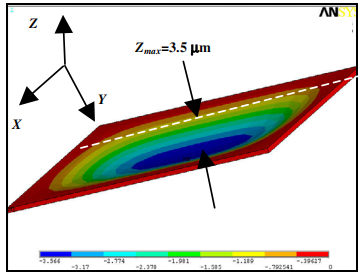This paper reports on the design, implementation and characterization of wafer-level packaging technology for a wide range of microelectromechanical system (MEMS) devices. The encapsulation technique is based on thermal decomposition of a sacrifificial polymer through a polymer overcoat to form a released thin-film organic membrane with scalable height on top of the active part of the MEMS. Hermiticity and vacuum operation are obtained by thin-film deposition of a metal such as chromium, aluminum or gold. The thickness of the overcoat can be optimized according to the size of the device and differential pressure to package a wide variety of MEMS such as resonators, accelerometers and gyroscopes. The key performance metrics of several batches of packaged devices do not degrade as a result of residues from the sacrifificial polymer. A Q factor of 5000 at a resonant frequency of 2.5 MHz for the packaged resonator, and a static sensitivity of 2 pF g−1 for the packaged accelerometer were obtained. Cavities as small as 0.000 15 mm3 for the resonator and as large as 1 mm3 for the accelerometer have been made by this method.
Wafer-level packaging constitutes a major cost in microsystem manufacturing [1]. Chip-level packaging of microelectromechanical system (MEMS) requires special techniques to protect the released MEMS during dicing. Wafer-level packaging of MEMS (prior to dicing) can be classifified into two main schemes: the first scheme, namely wafer bonding, includes bonding of a cap wafer (e.g., glass, silicon or ceramic) with cavity to the host wafer using anodic [2], fusion [3], eutectic [4], solder [5], adhesive [6] and glass frit [7] bonding techniques. The second scheme requires forming thin-film membranes and removal of sacrifificial organic or inorganic films [8–10]. Thick-film liquid crystal polymer and polymide have been used for RF MEMS packaging as well [11, 12]. The interconnections are made horizontally [4], or vertically in the cap (prior to bonding [13], or after thin-film sealing [9]) or in the MEMS wafer (after bonding [14]). The final assembly includes dicing, mounting or plastic injection molding. Most of the reported MEMS packaging techniques are costly (require bonding or high-temperature deposition), require large and complicated interconnections and are device specifific. Hermiticity is critical for MEMS operating in vacuum and biological environments .
This phase forms a cavity with desired height to cover the active part of MEMS (e.g. electrodes, beams, tethers, proof mass, etc), as shown in figure 1(b). Unity has good adhesion to most of the MEMS substrates, such as silicon, silicon dioxide and metals. The cavity height can be in the order of 1–100 µm (by spin casting) or few millimeters (by dispensing).
The second main phase in the packaging sequence is to cover the MEMS with a compliant, negative-tone photo-definable polymer, as shown in figure 1(c). The bond pads are opened via patterning the polymer overcoat. It is possible to create thick (up to 500 µm) pinhole-free cap over large-area MEMS. Various photo-definable polymers have been used in the literature for the fabrication and packaging of MEMS. This includes polymide encapsulation by Lockheed Martin [12], SU-8 release and encapsulation by Infineon Technologies [19] and benzocyclobutane (BCB) RF MEMS sealing by IMEC [20].

Fig1
In addition to direct photo-definition, patterning of the sacrificial polymer can also be done by etching or molding. Etching is suitable for small-area MEMS with wide/deep holes or fragile elements, e.g. HARPSS tunable capacitors and switches. To cover the wide trenches or protect the fragile MEMS against breaking, low-speed spinning of the Unity is desired, which will result in thick Unity films that limit the lithography resolution. It is hard to form well-shaped Unity channels thicker than 10–20 µm and narrower than 10–20 µm. Instead, etching of the Unity by using another mask is performed. The mask can be a metal (e.g. titanium) or an oxide deposited at low temperatures (e.g. 100 ◦C) . As shown in figure 4(a), thick Unity is spin coated, followed by deposition and patterning of the hard mask (PECVD oxide or titanium). Unity will then be etched in an oxygen plasma. Finally the hard mask is removed in buffered oxide etch (BOE) solution.